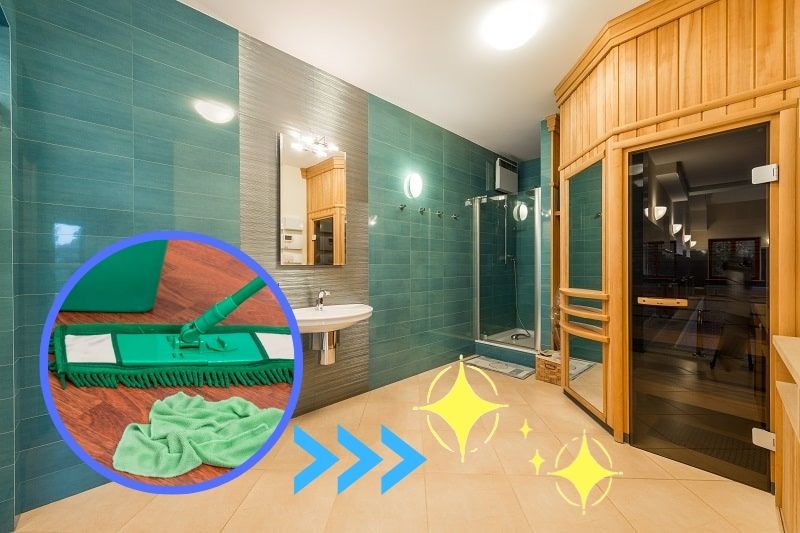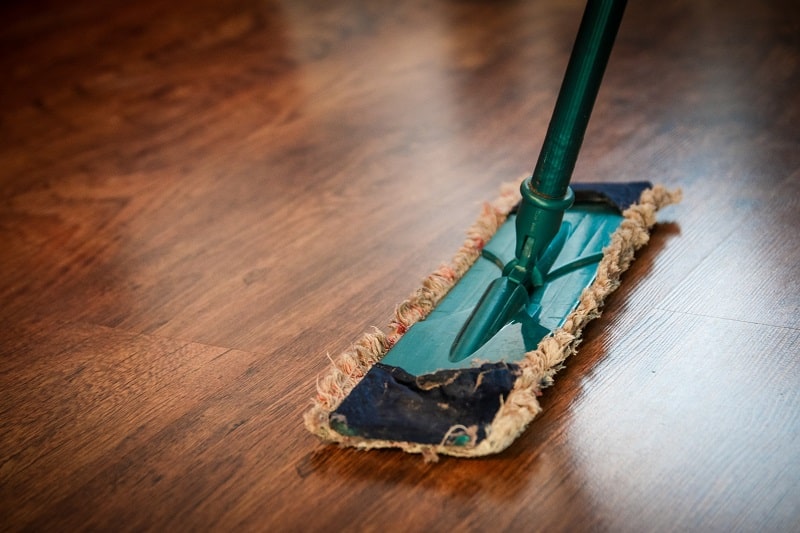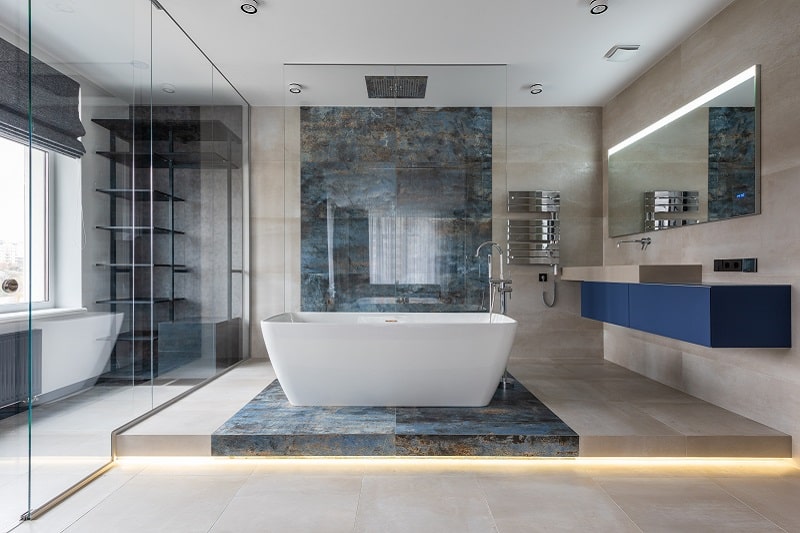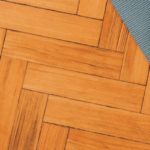Wet rooms take a cool, minimalist approach to bathrooms, but they’re not so cool when they’re covered in limescale and mould. Fortunately, wet room floors are easy to clean!
You can clean a wet room floor using a mop and bucket. Fill the bucket with warm water and your bathroom cleaner of choice, then dampen the mop in the solution. Use the mop to gently scrub the floor in small circles, then rinse away the dirt into the drain.
I’ll make sure all ground is covered in the rest of this article by providing more tips for keeping your wet room floor in good shape. I’ll also answer some common questions about wet rooms and recommend some floor and drain cleaning products.
Tips for Keeping a Wet Room Floor Clean
Wet room floors aren’t complicated, but there are different components to consider, like the drain and the grouting. You can also use different tools and cleaning solutions to make your wet room floor easier to maintain.
1. Rinse the floor after showering
Letting dirt and soap suds sit on your floor after showering will just lead to more cleaning for future you!
If you have a moveable shower head, use it to rinse the floor after you’ve showered, ensuring that all dirt and suds go down the drain. You can also use a cloth or sponge to quickly wipe the floor if some dirt isn’t budging.
2. Keep the floor dry when not in use

After you’ve rinsed the floor, you should make sure it’s mostly dry.
Keeping your wet room floor dry when it’s not in use will fight limescale and mould, which can form in damp conditions. It’ll also stop you from slipping!
Use a squeegee mop
You can use a normal cloth to wipe your wet room floor, but I’d recommend purchasing a squeegee mop; it’s like a rubber-bladed window wiper, but for the floor.
You can use a squeegee mop to quickly sweep leftover puddles into the drain, eliminating the need for bending over your shower drain with a cloth. Just use the handle to pull the water back towards your body for a smooth, sweeping motion.
Check out this cheap squeegee mop at The Dustpan and Brush Store. It’s specifically designed for wet room floors, and it has a telescopic handle for a long reach and compact storage.
3. Keep your wet room ventilated
To reduce the chance of mould and limescale gathering on your floor, make sure you use your wet room’s extractor fan for 30 minutes after each shower.
If your wet room has a window, let some fresh air circulate in your wet room to keep it dry when it’s not in use.
4. Clean the drains periodically
Pulling hair out of the shower drain is probably my least favourite pastime, but it’s a crucial part of maintaining a wet room.
A wet room’s functionality is centred around its drainage system, so you need to keep the drains unblocked and working efficiently.
Your wet room’s drainage system depends on the type of installation, but cleaning it should feel pretty intuitive.
How to clean a wet room drain
If there’s a drain cover, remove it first. You can use a cloth and non-abrasive bathroom cleaning spray to clean the drain cover and any gutters – banishing dirt, grease, and limescale.
Use your hands to dislodge any hair or dirt near the drain and dispose of it (you might want to wear rubber gloves for this part).
Try using a drain snake for blockages you can’t remove with your hands. I recommend this inexpensive clog remover and cleaning brush set on Amazon.co.uk, able to banish various blockages.
You can pour boiling water down and around the drain to rinse it clean after any dirt has been picked out.
If there’s a tough blockage, you can use a non-abrasive, non-corrosive drain cleaner to melt through the muck.
Try Green Gobbler Drain Clog Dissolver or HG Liquid Drain Unblocker for a non-caustic drain cleaner for your wet room drain.
Follow the instructions on the packaging of your chosen drain cleaner, and make sure any leftover cleaner is rinsed away after the job is done.
5. Mop the floor

Deep cleaning your wet room floor is inevitable, but it shouldn’t be a dramatic event if you follow the tips above to regularly maintain your floor.
How to mop a wet room floor
All you’ll need is a mop, bucket, warm water, and a non-abrasive bathroom cleaner.
- Fill the bucket with warm water and add in the recommended amount of bathroom cleaner, which can be found on your bathroom cleaner’s label.
- Submerge the mop in the solution and wring out some excess moisture.
- Gently scrub the floor in small circles, lifting any dirt and soap residue. Scrub in sections to keep track of where you’ve cleaned.
- Submerge the mop and use it to rinse the dirt into the drain.
- Continue to scrub and rinse with the mop until the floor is visibly clean.
- Use your shower head to rinse the floor cleaner away.
- Dry the floor by using a squeegee mop to sweep excess water towards the drain or wiping with a towel or cloth. Keep the room ventilated to help the floor dry faster.
6. Clean the grouting
Dirt loves to hide in bathroom tile grouting, and it’s the most common place you’ll find black mould. To avoid walking on a mouldy floor, you need to regularly scrub your grouting.
How to clean wet room grouting
To clean your wet room floor’s tile grouting, you can use a regular toothbrush or a special grout cleaning brush.
If the grouting looks fairly clean already, you can just gently scrub it using a brush and warm water.
For grimy grouting, you can make a paste with bicarbonate of soda.
- Put four teaspoons of water into half a cup of bicarbonate of soda, and mix it into a paste.
- Spread the paste onto your grouting and let it sit for 15 minutes, then scrub your grouting with a brush.
- Rinse away the dirt and paste with warm water.
You can also clean grout using a commercial grout cleaner, like HG Ready-to-use Grout Cleaner. Just follow the instructions on the product’s label to use it.
Are Wet Rooms Easier to Clean than Bathrooms?
Wet rooms eliminate all the clutter that can gather in normal bathrooms, and you can be liberal with the mop water since there’s a drain on the floor.
This means that wet rooms are generally easier to clean than normal bathrooms, but you’ll still need to regularly maintain your wet room to avoid mould and dirt building up.

How Long Does a Wet Room Floor Last?
It’s impossible to give an exact lifespan for your wet room floor, but its longevity depends on the quality of your floor’s installation and tiling.
Keeping your wet room floor functional relies on keeping it waterproof; this is made easier by applying a waterproof membrane to your floor, alongside primer and tape to keep corners and edges watertight. This should all be done on installation.
You can make your wet room floor last longer by following the tips above to keep it clean and healthy.
Can You Replace a Wet Room Floor?
If your wet room floor is installed properly, it should last for decades.
However, eventually, your wet room floor will get worn down, likely leading to water leakage. Your wet room floor can be replaced, but this should be done by an experienced and knowledgeable tradesperson who will waterproof it effectively.
Conclusion
It’s easy to clean a wet room floor, particularly if you regularly maintain your floor and rinse it after each shower.
You can mop a wet room floor with warm water and bathroom cleaner, and you should keep the floor dry when it’s not in use to avoid mould and limescale. Keep the bathroom well ventilated and use a squeegee mop to sweep water into the drain.
Make a homemade grout cleaning paste with water and bicarbonate of soda or use a commercial grout cleaner with a small brush to gently scrub your grouting clean. Keep your drainage system clean and unblocked with the help of a drain snake and drain cleaner, alongside boiling water.
Regularly clean and maintain your wet room floor to help it last for decades!

A recent uni graduate who likes writing, gaming, and drawing. I’m figuring out housekeeping tips alongside you while trying to provide eco-friendly cleaning options. Let’s find out how to use a tumble dryer together!






